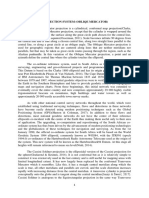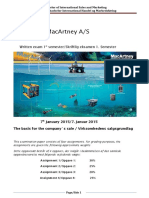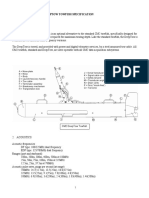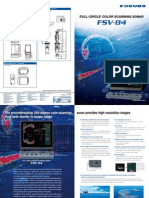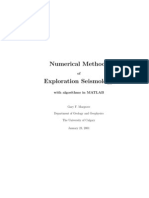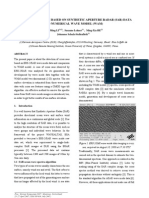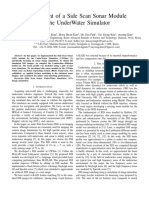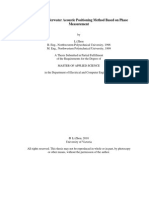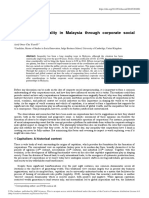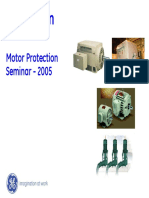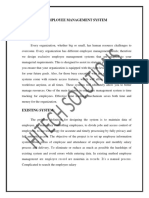Professional Documents
Culture Documents
Digital Elevation Model: Dem, DSM or DTM
Digital Elevation Model: Dem, DSM or DTM
Uploaded by
Jrey KumalahOriginal Description:
Original Title
Copyright
Available Formats
Share this document
Did you find this document useful?
Is this content inappropriate?
Report this DocumentCopyright:
Available Formats
Digital Elevation Model: Dem, DSM or DTM
Digital Elevation Model: Dem, DSM or DTM
Uploaded by
Jrey KumalahCopyright:
Available Formats
Digital elevation model
From Wikipedia, the free encyclopedia
3D rendering of a DEM of Tithonium Chasma on Mars
A digital elevation model is a digital model or 3D representation of a terrain's surface commonly for a planet (including Earth), moon, or asteroid created from terrain elevation data.
Contents
[hide]
1 DEM, DSM or DTM 2 Types of DEM 3 Production 4 Methods for obtaining elevation data used to create DEMs 5 Uses 6 Sources
6.1 United States
7 See also 8 References 9 DEM file formats 10 External links
DEM, DSM or DTM [edit]
There is no common usage of the terms digital elevation model (DEM), digital terrain model (DTM) and digital surface model (DSM) in scientific literature. In most cases the term digital surface
model represents the earth's surface and includes all objects on it. In contrast to a DSM, the digital terrain model represents the bare ground surface without any objects like plants and buildings (see the figure on the right).[1][2]
Surfaces represented by a Digital Surface Model include buildings and other objects. Digital Terrain Models represent the bare ground.
DTM is often used as a generic term for DSMs and DTMs, only representing height information without any further definition about the surface.[3] Other definitions equalise the terms DEM and DTM,[4] or define the DEM as a subset of the DTM, which also represents other morphological elements.[5] There are also definitions which equalise the terms DEM and DSM.[6] On the Web definitions can be found which define DEM as a regularly spaced GRID and a DTM as a three-dimensional model (TIN).[7] Most of the data providers (USGS,ERSDAC, CGIAR, Spot Image) use the term DEM as a generic term for DSMs and DTMs. All datasets which are captured with satellites, airplanes or other flying platforms are originally DSMs (like SRTM or the ASTER GDEM). It is possible to compute a DTM from high resolution DSM datasets with complex algorithms (Li et al., 2005). In the following the term DEM is used as a generic term for DSMs and DTMs.
Types of DEM [edit]
Heightmap of Earth's surface (including water and ice) inequirectangular projection, normalized as 8-bit grayscale, where lighter values indicate higher elevation
A DEM can be represented as a raster (a grid of squares, also known as a heightmap when representing elevation) or as a vector-basedtriangular irregular network (TIN). The TIN DEM dataset is also referred to as a primary (measured) DEM, whereas the Raster DEM is referred to as a secondary (computed) DEM. [8] The DEM
could be acquired through techniques such as photogrammetry, LiDAR, IfSAR,land surveying, etc. (Li et al. 2005). DEMs are commonly built using data collected using remote sensing techniques, but they may also be built from land surveying. DEMs are used often in geographic information systems, and are the most common basis for digitally-produced relief maps. While a DSM may be useful for landscape modeling, city modeling and visualization applications, a DTM is often required for flood or drainage modeling, land-use studies, geological applications, and other applications.[9]
Production [edit]
Relief map Sierra Nevada
Mappers may prepare digital elevation models in a number of ways, but they frequently use remote sensing rather than direct survey data. One powerful technique for generating digital elevation models is interferometric synthetic aperture radar where two passes of a radar satellite (such as RADARSAT1 orTerraSAR-X or Cosmo SkyMed), or a single pass if the satellite is equipped with two antennas (like the SRTM instrumentation), collect sufficient data to generate a digital elevation map tens of kilometers on a side with a resolution of around ten meters[citation needed]. Other kinds of stereoscopic pairs can be employed using the digital image correlation method, where two optical images are acquired with different angles taken from the same pass of an airplane or an Earth Observation Satellite (such as the HRS instrument of SPOT5 or the VNIR band of ASTER).[10] In 1986, the SPOT 1 satellite provided the first usable elevation data for a sizeable portion of the planet's landmass, using two-pass stereoscopic correlation. Later, further data were provided by the European RemoteSensing Satellite (ERS) using the same method, the Shuttle Radar Topography Mission using single-pass SAR and the ASTER instrumentation on the Terra satellite using double-pass stereo pairs.[10] The HRS instrument on SPOT 5 has acquired over 100 million square kilometers of stereo pairs. Older methods of generating DEMs often involve interpolating digital contour maps that may have been produced by direct survey of the land surface. This method is still used in mountain areas, where interferometry is not always satisfactory. Note that contour line data or any other sampled elevation
datasets (by GPS or ground survey) are not DEMs, but may be considered digital terrain models. A DEM implies that elevation is available continuously at each location in the study area. The quality of a DEM is a measure of how accurate elevation is at each pixel (absolute accuracy) and how accurately is the morphology presented (relative accuracy). Several factors play an important role for quality of DEM-derived products:
terrain roughness; sampling density (elevation data collection method); grid resolution or pixel size; interpolation algorithm; vertical resolution; terrain analysis algorithm; Reference 3D products include quality masks that give information on the coastline, lake, snow, clouds, correlation etc.
Methods for obtaining elevation data used to create DEMs [edit]
Gatewing X100 unmanned aerial vehicle
LIDAR Stereo photogrammetry from aerial surveys Block adjustment from optical satellite imagery Interferometry from radar data Real Time Kinematic GPS Topographic maps Theodolite or total station Doppler radar Focus variation Inertial surveys
Surveying and mapping drones
Uses [edit]
Digital Elevation Model - Red Rocks Amphitheater, Colorado processed byDroneMapper obtained using Falcon UAV
Bezmiechowa airfield 3D Digital Surface Model obtained using Pteryx UAV flying 200 m above hilltop
Digital Surface Model of motorwayinterchange construction site. Note that tunnels are closed.
Example DEM flown with the Gatewing X100 in Assenede
Digital Terrain Model Generator + Textures(Maps) + Vectors
Common uses of DEMs include:
Extracting terrain parameters Modeling water flow or mass movement (for example avalanches and landslides) Creation of relief maps Rendering of 3D visualizations. 3D flight planning Creation of physical models (including raised relief maps) Rectification of aerial photography or satellite imagery Reduction (terrain correction) of gravity measurements (gravimetry, physical geodesy) Terrain analysis in geomorphology and physical geography Geographic Information Systems (GIS) Engineering and infrastructure design Global positioning systems (GPS) Line-of-sight analysis Base mapping
Flight simulation Precision farming and forestry Surface analysis Intelligent transportation systems (ITS) Auto safety / Advanced Driver Assistance Systems (ADAS) Archaeology
Sources [edit]
A free DEM of the whole world called GTOPO30 (30 arcsecond resolution, approx. 1 km) is available, but its quality is variable and in some areas it is very poor. A much higher quality DEM from the Advanced Spaceborne Thermal Emission and Reflection Radiometer (ASTER) instrument of the Terra satellite is also freely available for 99% of the globe, and represents elevation at 30 meter resolution. A similarly high resolution was previously only available for the United States territory under the Shuttle Radar Topography Mission (SRTM) data, while most of the rest of the planet was only covered in a 3 arc-second resolution (around 90 meters). The limitation with the GTOPO30 and SRTM datasets is that they cover continental landmasses only, and SRTM does not cover the polar regions and has mountain and desert no data (void) areas. SRTM data, being derived from radar, represents the elevation of the first-reflected surface quite often tree tops. So, the data are not necessarily representative of the ground surface, but the top of whatever is first encountered by the radar. Submarine elevation (known as bathymetry) data is generated using shipmounted depth soundings. The SRTM30Plus dataset (used in NASA World Wind) attempts to combine GTOPO30, SRTM and bathymetric data to produce a truly global elevation model.[11] A novel global DEM of postings lower than 12 m and a height accuracy of less than 2 m is expected from the TanDEM-X satellite mission which started in July 2010. The most common grid (raster) spacing is between 50 and 500 meters. In gravimetry e.g., the primary grid may be 50 m, but is switched to 100 or 500 meters in distances of about 5 or 10 kilometers. Since 2002, the HRS instrument on SPOT 5 has acquired over 100 million square kilometers of stereo pairs used to produce a DTED2 format DEM (with a 30-meter posting) DEM format DTED2 over 50 million km.[12] The radar satellite RADARSAT-2 has been used by MacDonald, Dettwiler and Associates Ltd. to provide DEMs for commercial and military customers.[13] In 2014, acquisitions from radar satellites TerraSAR-X and TanDEM-X will be available in the form of a uniform global coverage with a resolution of 12 meters.[14] Many national mapping agencies produce their own DEMs, often of a higher resolution and quality, but frequently these have to be purchased, and the cost is usually prohibitive to all except public authorities and large corporations. DEMs are often a product of National LIDAR Dataset programs.
Free DEMs are also available for Mars: the MEGDR, or Mission Experiment Gridded Data Record, from the Mars Global Surveyor's Mars Orbiter Laser Altimeter (MOLA) instrument; and NASA's Mars Digital Terrain Model (DTM).[15]
United States [edit]
The US Geological Survey produces the National Elevation Dataset, a seamless DEM for the United States, Hawaii and Puerto Rico based on 7.5' topographic mapping. As of the beginning of 2006, this replaces the earlier DEM tiled format (one DEM per USGS topographic map).[16][17]
You might also like
- Data Abstraction and Problem Solving With Java Walls and Mirrors 3rd Edition Prichard Test BankDocument9 pagesData Abstraction and Problem Solving With Java Walls and Mirrors 3rd Edition Prichard Test Bankamandahillmpsxfbkrny100% (15)
- SM Me411 21 en 01Document97 pagesSM Me411 21 en 01Sulay Avila Llanos100% (1)
- Computer Engineering Drafting and Design ModulesDocument188 pagesComputer Engineering Drafting and Design Modulesjohn blancoNo ratings yet
- DMS-H System Manual Issue 1.6 April 2017Document108 pagesDMS-H System Manual Issue 1.6 April 2017Hao KietNo ratings yet
- Sdan 0025-0158 CDocument134 pagesSdan 0025-0158 CGis7No ratings yet
- History of Projection and Coordinate System in Malaysia PDFDocument41 pagesHistory of Projection and Coordinate System in Malaysia PDFWan FarihahNo ratings yet
- RFP V9.0 - Terms of Reference - GWP 2209-16-00Document187 pagesRFP V9.0 - Terms of Reference - GWP 2209-16-00mtor_scribdNo ratings yet
- Resampling 2D Lines Into Grid 5061777 02Document8 pagesResampling 2D Lines Into Grid 5061777 02Carlos A MoyaNo ratings yet
- GLS614 - CHAPTER 1C - Acoustic PositioningDocument59 pagesGLS614 - CHAPTER 1C - Acoustic PositioningHarith HnryusanNo ratings yet
- Shoreline Change Analysis and Its Application To Prediction-A Remote Sensing and Statistics Based ApproachDocument13 pagesShoreline Change Analysis and Its Application To Prediction-A Remote Sensing and Statistics Based ApproachFirman Tomo SewangNo ratings yet
- TURNSTILES HI-PE Metal Detector Literature and Operation ManualDocument44 pagesTURNSTILES HI-PE Metal Detector Literature and Operation ManualErick Navarrete50% (2)
- Backscatter and Seabed Image ReflectivityDocument5 pagesBackscatter and Seabed Image ReflectivityJuan David SantanaNo ratings yet
- Basic Wave Theory Review: Graham Warren Bureau of Meteorology AustraliaDocument33 pagesBasic Wave Theory Review: Graham Warren Bureau of Meteorology Australiarenda tiyarsoNo ratings yet
- Ultrasonic Sound WavesDocument12 pagesUltrasonic Sound WavesAgnivesh Sharma100% (1)
- GeoSwath Plus BrochureDocument16 pagesGeoSwath Plus BrochureAhmad Afandi100% (1)
- Theory of TidesDocument13 pagesTheory of TidesbaktinusantaraNo ratings yet
- Tidal CorrectionDocument2 pagesTidal CorrectionInne Puspita SariNo ratings yet
- MacArtney Final VersionDocument21 pagesMacArtney Final Versionysukka25No ratings yet
- Central Vs StringDocument16 pagesCentral Vs Stringrahul patraNo ratings yet
- Analisa 4 Dahlia Bi Tapak Autokira Ujian Mac 2020 Kelas 4 DahliaDocument2 pagesAnalisa 4 Dahlia Bi Tapak Autokira Ujian Mac 2020 Kelas 4 DahliaSopian MohamadNo ratings yet
- McClay, 1992-Glossary of Thrust Tectonics TermsDocument15 pagesMcClay, 1992-Glossary of Thrust Tectonics Termshazim_74No ratings yet
- EPC Contractor Daily Report January 15Document2 pagesEPC Contractor Daily Report January 15Caroline BookNo ratings yet
- Combined Least SquaresDocument21 pagesCombined Least Squaressowmiyanarayanan_k_j88No ratings yet
- Deep Tow SpecsDocument2 pagesDeep Tow SpecsHaqqu RamdhaniNo ratings yet
- Guidelines MultibeamDocument9 pagesGuidelines MultibeamDiego D. MantillaNo ratings yet
- Colour SonarDocument4 pagesColour SonarClarence PieterszNo ratings yet
- Introducing PolyCAD 9Document11 pagesIntroducing PolyCAD 9Ramon Velasco StollNo ratings yet
- Daily Report 15-Aug-23Document3 pagesDaily Report 15-Aug-23amr.gaber.mohamedNo ratings yet
- Lecture #22: Synthetic Aperture Radar: Fundamentals of Radar Signal ProcessingDocument58 pagesLecture #22: Synthetic Aperture Radar: Fundamentals of Radar Signal ProcessingMuhammad RizwanNo ratings yet
- Coil Survey DisingerDocument10 pagesCoil Survey Disingermoonrock1No ratings yet
- DGPSDocument20 pagesDGPStobinonline15730100% (1)
- Effective MagnetometerDocument17 pagesEffective MagnetometercartamenesNo ratings yet
- Lankston Refraction TR102Document55 pagesLankston Refraction TR102Harold G. Velasquez SanchezNo ratings yet
- Basics of Least Squares Adjustment Computation in - 3Document6 pagesBasics of Least Squares Adjustment Computation in - 3putra sahajaNo ratings yet
- Discuss The Use of Magnetic Methods in Engineering Geological SurveysDocument11 pagesDiscuss The Use of Magnetic Methods in Engineering Geological SurveysSrikanth JutruNo ratings yet
- Reflection and Diffraction Around Breakwaters PDFDocument125 pagesReflection and Diffraction Around Breakwaters PDFbokasubaNo ratings yet
- Rotation Matrix DefintionDocument2 pagesRotation Matrix Defintionpradnya RamgudeNo ratings yet
- General Facts About The Lidar TechniqueDocument29 pagesGeneral Facts About The Lidar TechniqueCirkuito100% (1)
- SBP IngDocument18 pagesSBP Ingdung_trinh_11No ratings yet
- Echo Surveyor VI Flyer PDFDocument2 pagesEcho Surveyor VI Flyer PDFThomas ThomasNo ratings yet
- CEPD03 Coastal Sediment Transport 6Document30 pagesCEPD03 Coastal Sediment Transport 6Michael DixonNo ratings yet
- Rotational MatrixDocument6 pagesRotational MatrixArun GuptaNo ratings yet
- Release NotesDocument152 pagesRelease Notestesttest3846No ratings yet
- An Introduction To GNSS PDFDocument73 pagesAn Introduction To GNSS PDFCristian M. VăduvaNo ratings yet
- NMES MargraveDocument160 pagesNMES MargravebrahmagitamNo ratings yet
- AZIPROPDocument4 pagesAZIPROPBudhi SantosoNo ratings yet
- NetMCCtrlDocument5 pagesNetMCCtrlPabodo TomNo ratings yet
- Hydrographic SurveyingDocument62 pagesHydrographic SurveyingSridhar Natarajan100% (1)
- GSS614 - GLS614 - CHAPTER 2 - Underwater Acoustic and SonarDocument44 pagesGSS614 - GLS614 - CHAPTER 2 - Underwater Acoustic and SonarSh LyNo ratings yet
- CoordinatesDocument82 pagesCoordinatesSnehalagoo LagooNo ratings yet
- Cross Sea Detection Based On Synthetic Aperture Radar (Sar) Data and Numerical Wave Model (Wam)Document6 pagesCross Sea Detection Based On Synthetic Aperture Radar (Sar) Data and Numerical Wave Model (Wam)Gautam SudhirNo ratings yet
- Aqwa Vs SeaFEM Vs WamitDocument4 pagesAqwa Vs SeaFEM Vs Wamitrajumj66No ratings yet
- WEATHER FORECAST FugroDocument18 pagesWEATHER FORECAST FugrohaitacvietnamNo ratings yet
- Side Scan SonarDocument4 pagesSide Scan SonarMuh ItsnaniNo ratings yet
- Alat Survey Single BeamDocument4 pagesAlat Survey Single BeamArdana Denta DyaksaNo ratings yet
- Thesis LiZhou FinalDocument128 pagesThesis LiZhou Finalauto_knightNo ratings yet
- Masaferro Et Al 2003 TLEDocument8 pagesMasaferro Et Al 2003 TLEPatrick EllisNo ratings yet
- Introduction To Synthetic Aperture Sonar PDFDocument27 pagesIntroduction To Synthetic Aperture Sonar PDFnaivedya_mishraNo ratings yet
- Marine FuelsDocument31 pagesMarine FuelsAlfi DelfiNo ratings yet
- FM7 Reference ManualDocument471 pagesFM7 Reference ManualIndra SetyaNo ratings yet
- Terrain AnalysisDocument2 pagesTerrain Analysisrajib.geosci2No ratings yet
- DTM SourceDocument6 pagesDTM SourceHand YoungNo ratings yet
- Chapter SevenDocument30 pagesChapter Seveneyoba2590No ratings yet
- Heightmap: Exploring Terrain Representation through Computer VisionFrom EverandHeightmap: Exploring Terrain Representation through Computer VisionNo ratings yet
- Is Inequality in Malaysia Really Going Down? A Puzzle ExploredDocument40 pagesIs Inequality in Malaysia Really Going Down? A Puzzle ExploredJrey KumalahNo ratings yet
- Addressing Inequality in Malaysia Through Corporate Social IntrapreneurshipDocument8 pagesAddressing Inequality in Malaysia Through Corporate Social IntrapreneurshipJrey KumalahNo ratings yet
- Impact On Poverty and Income Inequality in Malaysia's Economic GrowthDocument9 pagesImpact On Poverty and Income Inequality in Malaysia's Economic GrowthJrey KumalahNo ratings yet
- Ethnic Inequality and Poverty in Malaysia: Martin RavallionDocument31 pagesEthnic Inequality and Poverty in Malaysia: Martin RavallionJrey KumalahNo ratings yet
- Impact On Poverty and Income Inequality in Malaysi PDFDocument9 pagesImpact On Poverty and Income Inequality in Malaysi PDFJrey KumalahNo ratings yet
- 02 WholeDocument298 pages02 WholeJrey KumalahNo ratings yet
- Social Inequality in Malaysia: November 2017Document13 pagesSocial Inequality in Malaysia: November 2017Jrey KumalahNo ratings yet
- Waste Management Challenges in Sustainable Development of IslandsDocument10 pagesWaste Management Challenges in Sustainable Development of IslandsJrey KumalahNo ratings yet
- CS583 Unsupervised LearningDocument95 pagesCS583 Unsupervised LearningJrey KumalahNo ratings yet
- CN and WP Lab ManualDocument101 pagesCN and WP Lab ManualBam NoiceNo ratings yet
- JUSHI OrgDocument3 pagesJUSHI Orgsandesh sawateNo ratings yet
- Ge Multilin Motor Protection SeminarDocument175 pagesGe Multilin Motor Protection SeminarRamakrishna100% (1)
- Catalogo HeidenhainDocument60 pagesCatalogo HeidenhainDavid Diaz InfanteNo ratings yet
- Nougat Porting GuideDocument3 pagesNougat Porting GuideMandeep KumarNo ratings yet
- Solutions ManualDocument200 pagesSolutions ManualNguyễn Tấn TàiNo ratings yet
- Transceiver Group G12 DT DescriptionDocument15 pagesTransceiver Group G12 DT DescriptionBảo Hân NguyễnNo ratings yet
- Oracle OBIEE Tutorial Answer To BI PublisherDocument24 pagesOracle OBIEE Tutorial Answer To BI PublisherAmit Sharma100% (2)
- CipherTrust Manager - Hands-On - CTE - LinuxDocument25 pagesCipherTrust Manager - Hands-On - CTE - LinuxbertinNo ratings yet
- Sap Hana Mock Test IIDocument4 pagesSap Hana Mock Test II18r91a1255No ratings yet
- Usage of RIP SoftwareDocument6 pagesUsage of RIP SoftwareIbrahim MunirNo ratings yet
- Elgg - Ubuntu Installation ProcedureDocument4 pagesElgg - Ubuntu Installation ProcedureNaresh KumarNo ratings yet
- Web Services.Document13 pagesWeb Services.vinaygarg2005No ratings yet
- How To Setup Remote Desktop ServicesDocument9 pagesHow To Setup Remote Desktop ServicesdynesNo ratings yet
- Brake Dan Boogie VISKORDocument2 pagesBrake Dan Boogie VISKORsyawalulail01No ratings yet
- Ujet Web SDKDocument1 pageUjet Web SDKJonh Vitaliy100% (1)
- Class 18Document26 pagesClass 18Ilham HafizNo ratings yet
- Sadcas TR 14 - Sadcas Policy - Iso Iec 17025-2017 TransitionDocument10 pagesSadcas TR 14 - Sadcas Policy - Iso Iec 17025-2017 TransitionSuresh KumarNo ratings yet
- Billiard DocumentationDocument6 pagesBilliard DocumentationFlash Game StudioNo ratings yet
- Get Free Homework Answers OnlineDocument8 pagesGet Free Homework Answers Onlineewaw35mr100% (1)
- Ir 4426Document12 pagesIr 4426Juninbox1No ratings yet
- Properties of Square NumbersDocument5 pagesProperties of Square Numbersflash newsNo ratings yet
- A A I Holdings IncDocument1 pageA A I Holdings IncChristian Rey NotarioNo ratings yet
- A Report On Student Industrial Work Experience Scheme (Siwes) Training Programme (May 2016 - October 2016)Document36 pagesA Report On Student Industrial Work Experience Scheme (Siwes) Training Programme (May 2016 - October 2016)Dwayne ChimaNo ratings yet
- LogDocument46 pagesLogLucil mae VillegasNo ratings yet
- Employee Management SystemDocument4 pagesEmployee Management SystemkanchangawndeNo ratings yet





